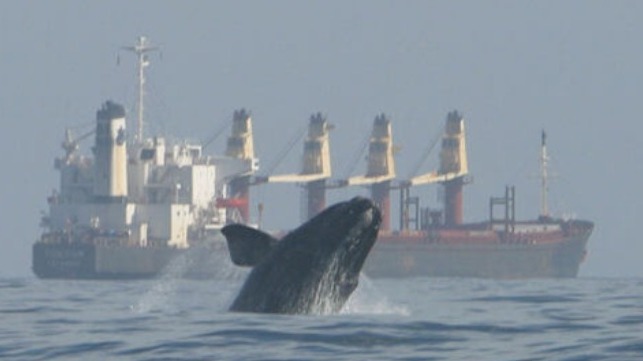Oceana Finds Vessels Exceeding Speed Limits Endangered Right Whales

The international advocacy organization for ocean conservation Oceana released a new report again showing that most vessels are exceeding speed limits in areas designed to protect critically endangered North Atlantic right whales. The report from the environmental group Oceana analyzed vessel speeds from 2017 to 2020 in speed zones established by the National Oceanic and Atmospheric Administration (NOAA) along the U.S. Atlantic coast and found non-compliance was as high as almost 90 percent in mandatory speed zones, and non-cooperation was as high as almost 85 percent in voluntary areas.
Oceana reports that collisions with vessels are one of two leading causes of injury and death for North Atlantic right whales, whose population is estimated at just 360 remaining. Studies have found that slowing vessel speeds to 10 knots reduce a North Atlantic right whale’s risk of death from vessel strikes by between 80 and 90 percent. The analysis is based on data from the tracking devices on vessels 65 feet or larger, but Oceana says smaller vessels are also at fault. As an example, they cited the death of a calf earlier this year from propeller wounds, broken ribs, and a fractured skull from a collision with a 54-foot recreational fishing vessel.
As a result of these findings, Oceana is urgently calling on NOAA to immediately revise vessel speed regulations for the U.S. Atlantic including expand and establish new warning areas; make compliance with restricted areas mandatory; and expand speed requirements to include vessels under 65 feet in length.
“Vessels are speeding, North Atlantic right whales are dying, and there’s not enough accountability,” said Whitney Webber, campaign director at Oceana. “Oceana’s analysis shows that speeding vessels are rampant throughout North Atlantic right whales’ migration route, all along the East Coast, and in both mandatory and voluntary speed zones. North Atlantic right whales are dying from vessel strikes and NOAA must take action to prevent this. If NOAA is serious about its mandate to save North Atlantic right whales from extinction, speed zones must be designated in the areas where whales currently are, and they must be enforced. Until speed zone rules are mandatory and violators held accountable, North Atlantic right whales will continue to die on NOAA’s watch.”
NOAA uses two different types of management tools to help protect North Atlantic right whales: permanently designated mandatory Seasonal Management Area (SMA) speed zones in places where whales are expected to be, and reactive voluntary Dynamic Management Area (DMA) speed zones when a whale is spotted. DMAs suggest that vessels avoid the area and have a voluntary speed limit of 10 knots. In contrast, SMAs require vessels to slow down to 10 knots.
Oceana analyzed self-reported vessel speeds and location data to track vessel speeds and positions in North Atlantic right whale conservation areas. DMAs were broken up into four regions: Gulf of Maine, Southern New England, Mid-Atlantic, and the Southern States. Oceana found that at best, the highest level of compliance with mandatory 10-knot speed limits was only around two-thirds of vessels in the area near Cape Cod, Massachusetts while the worst was almost 90 percent of vessels violating the mandatory 10-knot speed limit in the Wilmington, North Carolina, to Brunswick, Georgia, region. Other areas with low compliance included the Ports of New York/New Jersey (almost 80 percent non-compliance); Georgia to Florida (over 70 percent non-compliance); the entrance to the Chesapeake Bay (almost 65 percent non-compliance); and the entrance to the Delaware Bay (over 55 percent non-compliance).
Cargo vessels were cited as being the least compliant vessel type, representing about 42 percent of offenders in DMAs and around 50 percent of offenders in SMAs.
Studies have found that the speed of a vessel is a major factor in vessel-related collisions with North Atlantic right whales. At high speeds, vessels cannot maneuver to avoid them, and North Atlantic right whales swim too slowly to be able to move out of the way. This puts them at great risk of being struck, which can cause deadly injuries from blunt-force trauma or cuts from propellers. Entanglement in fishing gear used to catch lobster, snow crab and bottom-dwelling fish like halibut, flounder and cod is the other leading cause of North Atlantic right whale deaths.
